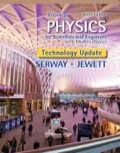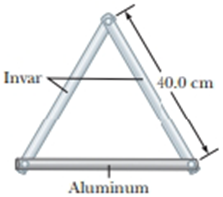
Concept explainers
Two metal bars are made of invar and a third bar is made of aluminum. At 0°C, each of the three bars is drilled with two holes 40.0 cm apart. Pins are put through the holes to assemble the bars into an equilateral triangle as in Figure P18.31. (a) First ignore the expansion of the invar. Find the angle between the invar bars as a function of Celsius temperature. (b) Is your answer accurate for negative as well as positive temperatures? (c) Is it accurate for 0°C? (d) Solve the problem again, including the expansion of the invar. Aluminum melts at 660°C and invar at 1 427°C. Assume the tabulated expansion coefficients are constant. What are (e) the greatest and (f) the smallest attainable angles between the invar bars?
Figure P18.31

(a)
Answer to Problem 19.54AP
Explanation of Solution
Given info: The distance between two holes drilled at
In the given diagram consider the right triangle that each invar bar makes with one half of the aluminum bar.
Then, the angle is,
Here,
Rearrange the above equation for
Conclusion:
Therefore, the angle between the invar bars as a function of Celsius temperature is
(b)
Answer to Problem 19.54AP
Explanation of Solution
Given info: The distance between two holes drilled at
If the temperature drops, the Celsius temperature becomes negative. The negative value of the Celsius temperature describes the contraction of the bars. So the answer is accurate for the negative temperature same as the positive temperature.
Conclusion:
Therefore, yes the answer is accurate for negative as well as positive temperature.
(c)
Answer to Problem 19.54AP
Explanation of Solution
Given info: The distance between two holes drilled at
The expression for the angle between the invar bars is,
Substitute
The value of each angle of the right angle triangle is
Conclusion:
Therefore, Yes, the answer is accurate at
(d)
Answer to Problem 19.54AP
Explanation of Solution
Given info: The distance between two holes drilled at
In the given diagram consider the right triangle that each invar bar makes with one half of the aluminum bar.
Then, the angle between invar bars and aluminum bar is,
Here,
Rearrange the above equation for
Conclusion:
Therefore, the angle between the invar bars and the aluminum bar as a function of Celsius temperature is
(e)
Answer to Problem 19.54AP
Explanation of Solution
Given info: The distance between two holes drilled at
The average coefficient of linear expansion of the aluminum is
The average coefficient of linear expansion of the invar is
The greatest angle is occur at
The equation for the angel between the invar bars is,
Substitute
Conclusion:
Therefore, the greatest attainable angle between the invar bars is
(f)
Answer to Problem 19.54AP
Explanation of Solution
Given info: The distance between two holes drilled at
The average coefficient of linear expansion of the aluminum is
The average coefficient of linear expansion of the invar is
The smallest angle is occur at
The equation for the angel between the invar bars is,
Substitute
Conclusion:
Therefore, the smallest attainable angle between the invar bars is
Want to see more full solutions like this?
Chapter 19 Solutions
EBK PHYSICS FOR SCIENTISTS AND ENGINEER
- 2.) A 50.0 resistor is connected to a cell of emf 3.00 V. The voltmeter and the ammeter in the circuit are ideal. V A 50.00 (a) The current in the ammeter is 59.0 mA. Calculate the internal resistance of the cell. The circuit is changed by connecting another resistor R in parallel to the 50.0 resistor. V A 50.00 R (b) Explain the effect of this change on R is made of a resistive wire of uniform cross-sectional area 3.1 × 10-8 m², resistivity 4.9 × 10-70m and length L. The resistance of R is given by the equation R = KL where k is a constant. (b.i) the reading of the ammeter. [2] (b.ii) the reading of the voltmeter. [2] (c) Calculate k. State an appropriate unit for your answer. [3] [2]arrow_forwardNo chatgpt pls will upvotearrow_forwardNo chatgpt pls will upvotearrow_forward
- A rod 12.0 cm long is uniformly charged and has a total charge of -20.0 μc. Determine the magnitude and direction of the electric field along the axis of the rod at a point 32.0 cm from its center. 361000 ☑ magnitude What is the general expression for the electric field along the axis of a uniform rod? N/C direction toward the rodarrow_forwardA certain brand of freezer is advertised to use 730 kW h of energy per year. Part A Assuming the freezer operates for 5 hours each day, how much power does it require while operating? Express your answer in watts. ΜΕ ΑΣΦ ? P Submit Request Answer Part B W If the freezer keeps its interior at a temperature of -6.0° C in a 20.0° C room, what is its theoretical maximum performance coefficient? Enter your answer numerically. K = ΜΕ ΑΣΦ Submit Request Answer Part C What is the theoretical maximum amount of ice this freezer could make in an hour, starting with water at 20.0°C? Express your answer in kilograms. m = Ο ΑΣΦ kgarrow_forwardDescribe the development of rational choice theory in sociology. Please includearrow_forward
- A-E pleasearrow_forwardA 11.8 L gas tank containing 3.90 moles of ideal He gas at 26.0°C is placed inside a completely evacuated insulated bell jar of volume 39.0 L .A small hole in the tank allows the He to leak out into the jar until the gas reaches a final equilibrium state with no more leakage. Part A What is the change in entropy of this system due to the leaking of the gas? ■ ΜΕ ΑΣΦ AS = ? J/K Submit Request Answer Part B Is the process reversible or irreversible?arrow_forwardA-E pleasearrow_forward
- Three moles of an ideal gas undergo a reversible isothermal compression at 20.0° C. During this compression, 1900 J of work is done on the gas. For related problem-solving tips and strategies, you may want to view a Video Tutor Solution of Entropy change in a free expansion. Part A What is the change of entropy of the gas? ΤΕ ΑΣΦ AS = Submit Request Answer J/Karrow_forward5.97 Block A, with weight 3w, slides down an inclined plane S of slope angle 36.9° at a constant speed while plank B, with weight w, rests on top of A. The plank is attached by a cord to the wall (Fig. P5.97). (a) Draw a diagram of all the forces acting on block A. (b) If the coefficient of kinetic friction is the same between A and B and between S and A, determine its value. Figure P5.97 B A S 36.9°arrow_forwardPlease take your time and solve each part correctly please. Thank you!!arrow_forward
 College PhysicsPhysicsISBN:9781285737027Author:Raymond A. Serway, Chris VuillePublisher:Cengage Learning
College PhysicsPhysicsISBN:9781285737027Author:Raymond A. Serway, Chris VuillePublisher:Cengage Learning Principles of Physics: A Calculus-Based TextPhysicsISBN:9781133104261Author:Raymond A. Serway, John W. JewettPublisher:Cengage Learning
Principles of Physics: A Calculus-Based TextPhysicsISBN:9781133104261Author:Raymond A. Serway, John W. JewettPublisher:Cengage Learning Physics for Scientists and Engineers: Foundations...PhysicsISBN:9781133939146Author:Katz, Debora M.Publisher:Cengage Learning
Physics for Scientists and Engineers: Foundations...PhysicsISBN:9781133939146Author:Katz, Debora M.Publisher:Cengage Learning College PhysicsPhysicsISBN:9781305952300Author:Raymond A. Serway, Chris VuillePublisher:Cengage Learning
College PhysicsPhysicsISBN:9781305952300Author:Raymond A. Serway, Chris VuillePublisher:Cengage Learning Physics for Scientists and Engineers, Technology ...PhysicsISBN:9781305116399Author:Raymond A. Serway, John W. JewettPublisher:Cengage Learning
Physics for Scientists and Engineers, Technology ...PhysicsISBN:9781305116399Author:Raymond A. Serway, John W. JewettPublisher:Cengage Learning Physics for Scientists and EngineersPhysicsISBN:9781337553278Author:Raymond A. Serway, John W. JewettPublisher:Cengage Learning
Physics for Scientists and EngineersPhysicsISBN:9781337553278Author:Raymond A. Serway, John W. JewettPublisher:Cengage Learning





